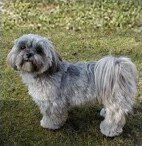 As adorable as they may be, breeds with long fur in their faces, like Lhasa Apsos, Shih Tzus and Malteses, have unique challenges including tear stains. You may have noticed these—they’re dark-colored stains or moisture around the dog’s eyes. They are particularly noticeable on dogs that have light-colored fur. Animals with bulging or protruding eyes like Pugs or Shih Tzus are even more prone to dog tear stains.
As adorable as they may be, breeds with long fur in their faces, like Lhasa Apsos, Shih Tzus and Malteses, have unique challenges including tear stains. You may have noticed these—they’re dark-colored stains or moisture around the dog’s eyes. They are particularly noticeable on dogs that have light-colored fur. Animals with bulging or protruding eyes like Pugs or Shih Tzus are even more prone to dog tear stains.
There is not any one cause in particular that is to blame for this problem. Every animal’s case is different even though it is a common problem amongst dogs, particularly small dogs, with long fur in their faces. This unsightly problem is caused by a number of factors:
– Genetics
– Irritation
– Tearing excessively from bacteria or yeast
– Ear infections
– Dyes and minerals from food or water
– Allergies
– Blocked tear ducts
Before moving to treat with dog tear stain removers, it’s important to consult with a vet to make sure your pet’s health is considered. A single factor or several may be at work in causing your dog’s tear stains. Your vet will have insight into whether or not this is a quick at-home-fix or if it is a medical cause that requires additional attention.
While waiting for a veterinarian’s diagnosis on the cause of your dog’s tear stains, there are a couple of steps you can take at home to alleviate the problem in the meantime. There are many short-term solutions to take while your veterinarian determines a long-term fix.
Above all else, the problem comes from excess moisture. Wiping your pet’s eyes with warm rags will help keep the moisture from collecting and staining its fur further. Keeping the moisture at a minimum will also keep it from potentially becoming an eye infection.
Similarly, keeping a dog’s face fur trimmed is another means to keep tear stains reduced. By trimming the hair on their faces, the chance of irritation and staining itself are reduced. If your dog was suffering from fur getting into their eyes, they may have produced extra tears to flush that hair out, causing the tear stains. Alternatively, there may have been other irritants in their fur causing that agitation.
Another easy step to take to minimize tear stains is to evaluate the type of food and water your dog consumes. Some dog foods have artificial coloring, like dyes, that can build up in a dog’s system. The stains would largely be around a dog’s mouth but as they groom themselves and itch their faces, the coloring can easily move and stain other fur. In addition, the mineral content in your dog’s drinking water can add to the problem. A veterinarian may recommend finding other water sources, like purifying your existing water or using bottled water, to help minimize the issue.
One new option to treat tear stains is a product called Angels’ Eyes. Angels’ Eyes are supplements, made with beef, chicken and sweet potato to be palatable to an animal, that work through your animal’s digestive system. Angels’ Eyes can be used proactively or reactively to treat tear stains—your pet does not need to already have them in order to take these supplements. There are a wide variety of dosage strengths and quantities available on the market. If you decide to use this product, pay attention to how much to administer to your pet—the dosage strength and frequency will depend on your pet’s size and age.
Tear stains are an unsightly but treatable problem that tends to be most noticeable with small, furry dogs like Lhasa Apsos. Always check with your vet but there are at-home treatments as well!


